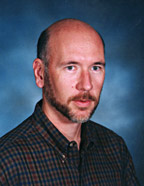A Diverse Picture of Early Humans Emerges
Rutgers geologist Craig Feibel dates bone fragments found near Lake Turkana in Kenya

The discovery goes a long way toward settling a 40-year old controversy about how diverse our early ancestors were, and Rutgers geologist Craig Feibel has played a key role in the research.
Feibel determined the age of three fossils – a lower jaw, a face and a fragment of another jaw – found near Lake Turkana in Kenya between 2007 and 2009. In the journal Nature, paleontologists Meave and Louis Leakey, Feibel and several co-authors report that these fossils are similar enough to a skull found in the same region in 1972 years ago to be members of the same species.
"For the past 40 years we have looked long and hard in the vast expanse of sediments around Lake Turkana for fossils that confirm the unique features of 1470’s (the 1972 skull is called KNM-ER 1470) face, and show us what its teeth and lower jaw would have looked like" Meave Leakey said. "At last we have some answers."
Some scientists had thought the 1972 skull, which had a big brain case and an unusually flat face, was just an oddly

Meave and Louise Leakey are directors of the Turkana Basin Institute and faculty members at Stony Brook University. Feibel has a joint appointment at Rutgers in the Department of Earth and Planetary Sciences and the Department of Anthropology in the School of Arts and Sciences.
The fragment was found in 2007. The upper jaw, or maxilla, was found was found enclosed in a chunk of rock in 2008, with only the teeth emerging to give clues that there was a hominin hidden beneath the bone. The first piece of the mandible found in 2009 had fresh breaks on it, and field crews found more pieces of it over the next few weeks, until the specimen was almost complete.
It was Feibel’s role to determine the age of these specimens. “Craig’s role is crucial, since without geologists like Craig we could not know how old our specimens are and how they relate to each other,” Leakey said. “It is because of Craig that we can say precisely how old these specimens are.”

“The key to the situation is a layer of volcanic ash, a really good marker,” Feibel said. “We know there was an eruption in the area 1.87 million years ago. The mandible came from right above that layer; the other two specimens from just below it.”
The mandible and jaw fragments give scientists some idea of what the rest of the 1972 skull looked like; the juvenile face shows that the 1972 skull was part of a separate species from Homo erectus, and not just an oddly shaped individual.
About 100,000 years separated the fossils below the ash layer from the one above it – a long weekend, in Feibel’s world. “All three of these individuals lived in the same area, but it’s not like they ever met each other,” he said.
Media Contact: Ken Branson
732-932-7084, ext. 633
E-mail: kbranson@ur.rutgers.edu